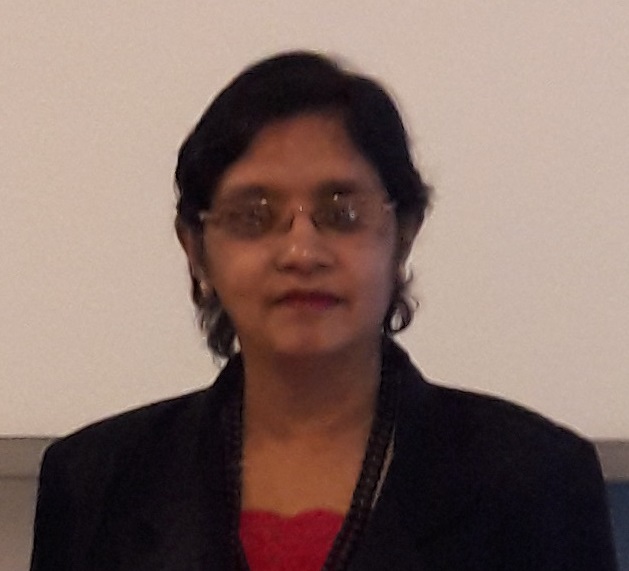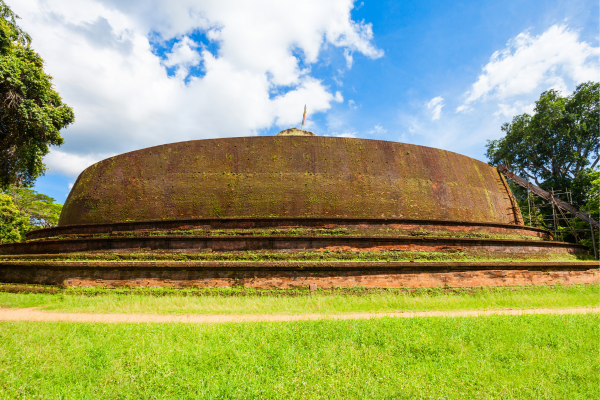Yudaganawa – largest stupa in the south and east of Sri Lanka
By Arundathie Abeysinghe
 Yudaganawa Stupa popularly known as Kinkini Stupa is located in proximity to Buttala about 46 kilometers on the scenic *Ella – Wellawaya Road. This large stupa has a circumference of 317 meters and dates back to the second century BC. The stupa is built halfway and there is a small stupa on it. According to *Mahawamsa (ancient chronicle of Sri Lanka), there had been a battle between *Prince Dutugemunu and his brother *Prince Saddha Tissa after the death of their father *King Kavantissa (205-161 BC who ruled the Kingdom of *Ruhuna).
Yudaganawa Stupa popularly known as Kinkini Stupa is located in proximity to Buttala about 46 kilometers on the scenic *Ella – Wellawaya Road. This large stupa has a circumference of 317 meters and dates back to the second century BC. The stupa is built halfway and there is a small stupa on it. According to *Mahawamsa (ancient chronicle of Sri Lanka), there had been a battle between *Prince Dutugemunu and his brother *Prince Saddha Tissa after the death of their father *King Kavantissa (205-161 BC who ruled the Kingdom of *Ruhuna).
According to folklore, this battle had taken place in the vicinity of Yudaganawa Temple. Prince Saddha Tissa has been in hiding in this temple in fear of his brother Prince Dutugemunu.
Yudganawa also known as Yuddhaganawa (in Sanskrit means “Yuddha” for war and “gana” for gathering or crowd or troops). Hence, Yudaganawa means coming together for combat.
There is another stupa in the vicinity known as Chulangai Viharaya dating back to the 12th century. The Buddha Statues in the Image House date back to 6th – 7th centuries.
This stupa is the largest in southern and eastern Sri Lanka, the area known as “Ruhuna” in the chronicles.
According to scholars, the construction of this stupa is a mystery as a massive construction of this nature is not mentioned in chronicles. There are various theories about the stupa. According to some, this stupa is from *Polonnaruwa Period as its shape resembles a hemisphere cut in half horizontally, as the stupa resembles Kota Vehera which was the typical structure of stupas constructed during King Parakramabahu I’s era (also known as Parakramabahu the Great – reign 1153-86). Demala Mahaesaya in Polonnaruwa and the Kota Vehera in Dedigama (a stupa located in close proximity to Nelumdeniya in Kegalle District – one of the 25 districts of Sri Lanka) built during King Parakramabahu’s era have similar structures. According to folklore, Yudaganawa was the hometown of King Parakramabahu I’s mother Ratnavali. Hence, it was the place where the King enshrined the ashes of his mother (as recorded in Verses 79, 71-72 of Mahawamsa).

Meanwhile, some scholars are of the view that the stupa was from the Anuradhapura Period (commonly known as the Kingdom of *Anuradhapura – 377 BC – 1017 AD).
- Ampara – Located in the Eastern Province of Sri Lanka 360 kilometers east of Colombo, Ampara is the main town of Ampara District.
- Anuradhapura – A major city in Sri Lanka (former Ceylon), the capital of Anuradhapura District. Anuradhapura was one of the ancient capitals of Sri Lanka and is famous for its well-preserved ruins of Sri Lankan civilization. Founded in the 4th century, Anuradhapura was the capital of Sri Lanka until the beginning of the 11th Anuradhapura is considered sacred to Buddhists and there are monasteries and stupas within an area of 40 square kilometers, Situated 205 kilometers north of Colombo, Anuradhapura was declared as the “Sacred City of Anuradhapura” and a World Heritage Site by UNESCO in 1982.
- Arugam Bay – A famous surfing destination on the east coast of Sri Lanka and popularly known as “Arugam Kuda” by locals.
- Badulla – Situated in lower central hills, Badulla is the capital city of *Uva Province and Badulla District.
- Chola conquest – This was a military invasion of the Anuradhapura Kingdom by the Chola Empire of Southern India, one of the longest ruling dynasties in world history. Initially, the Anuradhapura Kingdom was invaded in 993 AD and absorbed it into the Chola Empire of Southern India.
- Ella – Situated at an elevation of 1041 meters above sea level amid lush green forests, rolling carpets of tea and breathtaking mountains, Ella is a small town in the *Badulla District of *Uva Province. Popular among local and foreign tourists, Ella has a mild climate and a laid-back atmosphere.
- Kirinda – A coastal village in Sri Lanka located in the Southern Province.
- Mahawamsa –– “Great Chronicle” or “Great Dynasty” in Sinhala is the most significant work of Sri Lankan origin written in Pali Language. This Chronicle describes life and times of Sri Lankans from the arrival of Vijaya in 43 BC to the reign of King Mahasena from sixth century BC to fourth century AD. Culavamsa (lesser chronicle) covers the period from fourth century AD to British takeover of Sri Lanka in 1815. Mahavamsa consists of three parts covering a historical record of over two millennia. It is considered as the world’s longest unbroken historical record.
- Polonnaruwa – The Kingdom of Polonnaruwa or the ancient city of Polonnaruwa (also known as Pulastipura) was the second capital of Sri Lanka for three centuries from 11th to 13th After the *Chola conquest of Anuradhapura Kingdom, the center of administration was shifted to Polonnaruwa until 1232. Polonnaruwa has been declared a World Heritage Site by UNESCO.
- Pottuvil – Situated about four kilometers from popular surfers’ paradise *Arugam Bay, Pottuvil is a town in the *Ampara District of Sri Lanka and located on the eastern coast of Sri Lanka. Pottuvil is also known as Pothuvil or Poththuvil.
- Prince Dutugemunu – Also known as Duttagamini was born to a royal family in southern Sri Lanka. His parents were King Kavantissa and *Princess Vihara Maha Devi. Prince Dutugemunu became King Dutugemunu (164 BC – 140 BC). His brother was Prince Saddha Tissa.
- Princess Viharamahadevi – She was the daughter of King Kelanitissa and the Queen consort of King Kawantissa who was known as Queen Viharamahadevi after marriage. Queen Viharamahadevi was the mother of King Dutugemunu and Prince Saddhatissa. According to legends, the innocent Princess sacrificed her life to the sea to stop waves which were flooding inland. But when the boat was drifted to the sea, the sea had become calm and the boat had drifted inland saving the Princess. King Kawantissa had been impressed by her bravery and got married to her. The actual landing place of the boat is disputed by many scholars; according to some it is *Pottuvil, whereas some are of the view that it is *Kirinda. Yet, both Pottuvil and Kirinda belonged to *Ruhunu Kingdom in the past.
- Ruhunu Kingdom– Also known as Ruhunu Rata (meaning Ruhunu country in Sinhala) is a region of present Southern, *Uva and Eastern Sri Lanka, it was also known as Kingdom of Ruhuna, the center of a thriving civilization.
- Uva Province – This is the fourth largest province in Sri Lanka bordered by Central, Eastern and Southern provinces.
Image courtesy: travelwithuma.com







